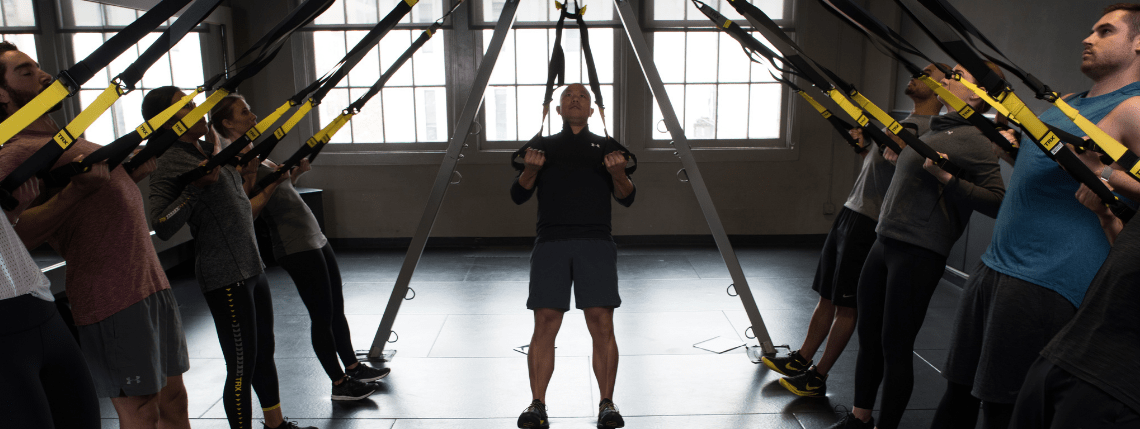Stay on top of the trends this year with Matt Gleed’s guide to the top fitness trends of 2022. As a TRX senior master trainer, he also calls on his extensive work with elite athletes to show us why TRX training is so beneficial.
Every year our friends at the American College of Sports Medicine (ACSM) put together feedback from surveys about the trends we will see this year. Well, this time we have gone all in and brought you all the top 10 trends together.
Let’s start with what the top 10 fitness trends for 2022 are:
- Wearable Technology: Devices like fitness trackers, smart watches and heart rate monitors that count steps and track heart rate, calories, sitting and sleep time, blood pressure and respiratory rate.
- Home Exercise Gyms: Use minimal equipment or treadmills and bikes at home for solo or family events.
- Outdoor Activities: Include workouts, walks, rides and organised events. Participants could meet in a park or garden, or even head to bike trails.
- Strength Training with Free Weights: Instructors focus on teaching proper form for exercises using barbells, kettlebells, dumbbells and/or medicine balls. Resistance progressively increases as correct form is accomplished.
- Exercise for Weight Loss: Using an exercise programme in tandem with the daily routine of calorie restriction to lose weight.
- Personal Training: Fitness testing and goal setting where a trainer is working one-on-one with a client to prescribe workouts specific to individual needs.
- High-Intensity Interval Training (HIIT): Involves short bursts of activity followed by a short period of rest or recovery in a 30-minute (or shorter) session.
- Bodyweight Training: Uses minimal equipment. Not limited to push-ups and pull-ups, this trend allows people to get ‘back to the basics’ with fitness.
- Online Live and On-demand Exercise Classes: Uses digital streaming technology to deliver group and individual exercise programmes online. Available 24/7 and can be a live or pre-recorded class.
- Health/Wellness Coaching: Integrates behavioural science into health promotion and lifestyle medicine programmes. A one-on-one and small group approach provides support, goal setting and encouragement.
In this Coach Corner, I have put together a workout using six exercises. To fully tick off every trend, get a heart rate device like a Myzone belt and watch the effect that these moves have on you, then take it outside to your clients or do your own how-to guide online.
Having been created as a solution for the military elite, TRX evolved to provide the wider population with an adaptable, full-body workout that you can’t outwork or outgrow. With the scope for hundreds of bodyweight exercises, and numerous progression options for each, regardless of whether you would class yourself as one of the many TRX enthusiasts, there are always ways to ramp up your workout.
Most of us have seen and used a TRX, but can we honestly say we know how to get the most out of this piece of kit?
TRX training is a form of suspension training that uses bodyweight exercises to develop strength, balance, flexibility and core stability simultaneously. There are three key reasons why TRX training is a fantastic way to work out your full body:
- Proven reduction of injury risk
Including TRX training in your workouts will activate more muscles and improve the strength of the core muscles and the stability around major joints.
At least 10 minutes of TRX training two or three times a week can improve your neuromuscular activation – the use of your nerves and muscles – which can significantly reduce the risk of injuries.
A review into functional training, as it applies to TRX Suspension Training and the practical implications from injury1, found that training in this manner effectively reduced the risk of injuries in the following ways:
- Lower limb injuries by 39%
- Ankle sprain injuries by 50%
- Acute knee injuries by 54%
- ACL injuries by 88%
- Ability to work through multi-planes of movement
When using the TRX, you will experience forces across all three planes of movement: sagittal, frontal and transverse. When using the TRX, you are working from a single anchor point, which forces the body to recruit muscles across all planes. Rotational and diagonal movements through the transverse plane are common in sports but less practised in gyms.
The TRX creates dynamic instability that the user needs to re-centre using muscle activation in order to perform the exercise. The body has to go through a stability process, working to engage muscles in surrounding tissues and quickly initiate motor control around the joints.
TRX training helps you to enhance the skill of movements across multi-planes with high levels of muscle engagement without sacrificing the movement quality. To alter the difficulty of an exercise, the amount of load can be increased with greater angles, ranges, speed or use of external weights.
- Enhanced core activation
Through every single TRX exercise, you will be challenging your core as the body fights for stability against the unstable, suspended base. This results in you having to recruit more core and stabilising muscles.
Core strength will improve with each session and working on exercises such as the TRX plank encourages your muscles to strengthen and recognise when it is most stable; for example, in a neutral position where your head, shoulders, spine and hips are all aligned.
Muscle activation of the core is essential for the maintenance of proper posture and researcher Dr Stuart McGill has found the spine to be up to 40% more resistant to compressive loads while in a neutral position.
Without your spine in a neutral position, you would potentially be without 25% of core engagement but, in a neutral position, you could gain up to 40% more activation – this could make a huge difference in performance of all sports, gym work and general life.
Six TRX exercises to take you to the next level
If you want to take your workout to a more advanced level, here are six TRX suspension training exercises to try out:
- TRX Side Plank with Pike Rotation
To develop lean muscle and shape up your waist this exercise is a must; working with as much range as possible and keeping the speed slow will add intensity too.
Strap length: Mid-calf
- Lie sideways to the anchor point, place both feet in foot cradles and align elbow under the shoulder.
- From the side plank position, pike the hips up and reach arm under torso at the same time.
- Lower hips and realign spine to side plank.
Common faults:
- Sagging in the hips and bending the knees.
- Alignment of spine. To fix, keep alignment of spine by squeezing the glutes and push heels into foot cradles.
Sets/reps: 3 sets of 10 reps, alternating each side
- TRX Power Pull
This is probably one of the hardest TRX exercises but one that builds great strength from a pulling motion and requires a lot of core tension and strength to perfect.
Strap length: Short
- Standing facing the anchor, hold a single handle with one arm; lean back with the other arm extended.
- Place feet flat on floor and extend hips to a flat spine position.
- Squeeze shoulder blades together, keeping elbows pulled into sides, and move body up towards anchor point.
- Return to start position, maintaining body alignment.
Common fault:
- Rotation in torso. To fix this, pull shoulders back and down and use the non-working hand as a visual aid to keep alignment.
Sets/reps: 3 sets on each arm of 10 reps, alternating arms each set
- TRX Lunge with (optional) 8-14kg Kettlebell
This exercise is great at creating stability around the ankle and knee, so it helps protect against injury and improve leg strength too.
Strap length: Mid-calf
- Stand facing away from the anchor and place one foot through both foot cradles.
- Lower into a lunge, bringing the suspended leg down towards the floor, while the standing knee bends at a 90⁰ angle.
- Rack the kettlebell at the shoulder and keep spine neutral.
Common fault:
- Leaning forwards and losing balance. To fix, keep looking ahead and focus on driving up through the foot.
Sets/reps: 3 sets on each leg of 10 reps, alternating legs each set
- TRX Plank Press
Working through your triceps, shoulders and chest muscles, this is a great but tough exercise; with your hands in a narrow position, it’s very different to the traditional press-up exercise.
Strap length: Mid-calf
- From a TRX plank on your forearms, ensure your palms are on the floor under your shoulders.
- Push through your palms and extend your elbows up into a high plank position.
- Lower your body back to the low plank with steady control.
Common fault:
- Using momentum to start the upwards movement. To fix, ensure your movement is focused with the downward force pushing you up.
Sets/reps: 3 sets of 10 reps
- TRX Swimmers Pull
This is a great upper-body workout working the chest, back, arms and core to high levels.
Strap length: Mid-length
- Start in the end position to measure appropriate stance and range of motion: stand facing anchor in offset stance, pulling TRX back, keeping arms by sides and palms facing away from the anchor point.
- Slowly lower body down so arms are in parallel to floor position, maintaining soft elbows throughout movement.
- Push through hands against handles, moving the body up towards anchor and keeping core engaged.
Common faults:
- Leaning forward and breaking the body’s position.
- Bending at the hips. To fix, keep chest lifted and core engaged to prevent bending at the hips and keep arms straight throughout movement
Sets/reps: 3 sets of 15 reps
- TRX Hip Press
This is a great advanced hamstring exercise, which develops hip strength and improves the athletic force of power production.
Strap length: Mid-calf
- Sit facing the anchor, place a single heel in both foot cradles and lie down with knee over hips to form a 90⁰ angle.
- Press hips up towards the ceiling and repeat.
Common fault:
- Knee comes out of alignment. To fix, keep knees stacked over hips in a 90⁰ angle.
Sets/reps: 3 sets of 10 reps
To grab 20% off any TRX product simply use the code TRXFITPRO
Author Bio:

Matt Gleed is a senior master trainer for TRX Training and fitness professional representing several leading brands, with 20+ years’ experience working directly with clients and 10+ of those years teaching personal trainers. He won the Fitness Contributor of the Year 2019 in the UK Fitness Awards and Outstanding Achievement Award in 2021.
Reference
- Hubscher, Zech, Pfeifer, Hansel, Vogt, & Banzer (2010); Mandelbaum et al (2005).







